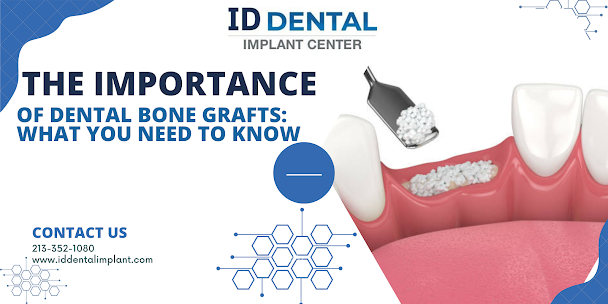The Importance of Dental Bone Grafts: What You Need to Know
Bone grafts may not be the first thing that springs to your mind when you think about different dental procedures.
However, bone graft dental procedures play a critical part in guaranteeing the effectiveness of numerous dental treatments.
So, understanding the significance of bone graft dental procedures is critical whether you are considering dental implants, periodontal surgery, or other dental operations.
In this post, we'll go over what you should know about the bone graft teeth process and why it is so vital for your overall dental health.
Let’s first understand what we mean when we say bone graft teeth or dental bone graft.
What Are Dental Bone Grafts?
If simply put together, dental bone graft procedures are the transplantation or augmentation of bone tissue to locations where there is a bone deficit or insufficiency.
So, this bone graft teeth surgery is commonly used to provide a secure and healthy foundation for dental implants, as well as to promote the formation of new bone in areas damaged by periodontal disease or trauma.
Now, let’s talk about why dental bone grafts are crucial and their benefits below!
Why Are Dental Bone Grafts Important & Their Benefits?
There are many different benefits of bone graft dental procedures for your overall health, which are as follows-
1. Dental implants:
Dental bone grafts are frequently necessary to enhance the jawbone in order for dental implants to be placed successfully.
Implants require a strong foundation in order to integrate and fuse with the surrounding bone.
So, dental implants have a much lower success rate when there is insufficient bone support.
2. Periodontal Disease:
Periodontal disease causes bone loss around the teeth, resulting in tooth mobility and, eventually, tooth loss.
Thus, dental bone grafts can assist in the regeneration of missing bone tissue and the creation of a stable environment for tooth retention or further dental treatments.
3. Aesthetic Factors:
Jaw bone loss can result in a sunken or aged appearance, which affects overall face attractiveness.
So, dental bone grafts can improve facial harmony by restoring the natural curves of the face and providing support for the lips and cheeks.
4. Long-Term Stability:
Bone grafts dental procedure improve the long-term stability and lifespan of many dental procedures.
Besides, they also serve as a strong foundation for dental implants, assuring their long-term success.
Bone grafts also help to keep dentures and bridges stable by avoiding bone resorption and ensuring correct fit and function.
5. Enhanced Quality of Life:
Dental bone transplants not only restore dental function but also improve the patient's quality of life.
Furthermore, they enable people to eat, speak, and smile with confidence, which boosts self-esteem and overall well-being.
Also, now, let’s talk about the four different types of dental bone grafts right here right now!
Four Types of Dental Bone Grafts:
Here are the four different types of dental bone grafts-
Autografts:
Autografts are bone transplants from another portion of the patient's body, such as the hip or jaw.
This is the gold standard graft since it delivers the best results in terms of integration and compatibility with the patient's own bone.
2. Allografts:
Before transplantation, bone tissue from a human donor is extensively treated and sterilized.
This graft eliminates the need for a second surgical site to harvest bone from the patient, making the procedure less invasive and lowering the risk of complications.
Xenografts:
Xenografts get made from animal bone tissue, commonly bovine or porcine.
Also, all biological components of the animal bone get removed, leaving only the mineral structure.
These serve as a scaffold for new bone formation and are eventually replaced over time by the patient's bone.
Alloplastic grafts:
Synthetic materials such as ceramics, polymers, or calcium-based materials get used in alloplastic grafts.
These bone graft teeth materials are biocompatible and act as scaffolding for the development of new bone.
Because of their availability and predictability, alloplastic grafts are a common choice.
So, these are the four different types of dental bone grafts you should know about.
Bottom Line-
Dental bone graft procedures are a substantial part of many dental procedures since they ensure the effectiveness and longevity of numerous treatments.
So, understanding the importance of dental bone grafts is critical whether you're considering dental implants, treating periodontal disease, or restoring facial aesthetics.
Well, you should always consult a trained dental practitioner to assess whether a bone graft is required for your individual dental needs and to discuss the best option for your oral health.
Not to mention, you can contact ID Dental & Implant Center. They are one of the best dental communities in Santa Maria & Los Angeles.
Visit their website to know more!
Always remember that a strong foundation is essential for a healthy and beautiful smile!

.jpg)


Comments
Post a Comment